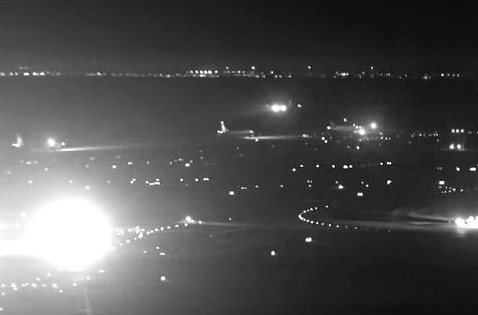The head of the US National Transportation Safety Board has slammed the way flight operations information is presented to pilots as “garbage” at a public hearing into a near catastrophe involving an Air Canada flight landing at San Francisco.
The Air Canada A320 carrying 140 passengers and crew from Toronto was cleared to land on San Francisco International Airport ’s runway 28R on July, 2017.
The experienced flight crew instead lined up on a crowded parallel taxiway due to what investigators determined was a lack of awareness.
Four aircraft — an Airbus A340, two Boeing 787s and a Boeing 737 — were on the taxiway awaiting takeoff clearance on July 7, 2017, when the pilots mistook if for the runway.
After flying over the first aircraft on the taxiway at 100ft above ground level the plane dropped as low as 59 feet — barely above the 56ft height of a Boeing 787 tail — before it began to gain height.
The aircraft performed a go-around and returned to land safely but experts said it could have been one of the worst catastrophes in aviation history.
The NTSB found the crew was unaware a parallel runway had been closed due to their “ineffective review of notice to airmen (NOTAM) before the flight and during the approach briefing”.
Contributing to this was the flight crew’s failure to tune to the instrument landing system (ILS) for backup lateral guidance as well as their firm belief they were on the right course, fatigue and breakdowns in crew resource management.
Also contributing was “Air Canada’s ineffective presentation of approach procedure and NOTAM information”.
READ our ratings for Air Canada
“Although the notice to airmen about the runway 28L closure appeared in the flight release and the aircraft communication addressing and reporting system message that were provided to the flight crew, the presentation of the information did not effectively convey the importance of the runway closure information and promote flight crew review and retention,’’ the NTSB said.
The NTSB called more effective presentation of flight operations information to encourage pilots to review it and remember what it said.
NTSB board members complained at the hearing that NOTAMs were an archaic system full of useless information that hid important details.
“(NOTAMs) are written in a language only a computer programmer can understand,” US media quoted NTSB chairman Robert L. Sumwalt as saying. “NOTAMs are just a bunch of garbage.”
Sumwalt said the mistakes identified in the report highlighted the need for a further review of approach and landing procedures.
“This event could very easily have had a catastrophic outcome,’’ he said. “The recommendations issued as a result of this investigation, if implemented, will help prevent the possibility of a similar incident from occurring in the future.”
Other recommendations issued to the US Federal Aviation Administration and Transport Canada addressed issues such as the need for aircraft landing at primary airports within class B and class C airspace to be equipped with a system that alerts pilots when an airplane is not aligned with a runway surface.
The NTSB also called for a method to more effectively signal a runway closure to pilots when at least one parallel runway remains in use, and modifications to airport surface detection equipment systems to detect potential taxiway landings and provide alerts to air traffic controllers.
The FAA, which says it is looking at simplifying NOTAMs, modified night time landing procedures at San Francisco as a result of the incident.
























